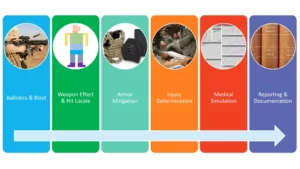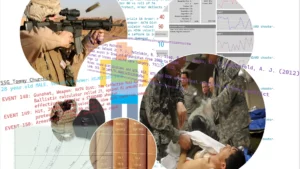Background
Battle Trauma Engine (BTE) is a stochastic injury generation system for gunshot and blast trauma, funded by the Joint Warfighter Medical Research Program as “OPUS-C: Open-Source Universal Simulated Casualty with a Scalable Weapons Effect & Injury Model for Virtual Medical Training.”
BTE is a tool for many kinds of simulations involving traumatic injuries; from combat simulations to crime event sims and mass casualty exercises. It includes everything necessary to turn event driven simulations into medical simulations, permanently bridging the gap between tactical/military and medical simulations. Now every character, combatant or not, is a detailed medical story and even a medical simulation exercise.
Objectives
This trauma engine applies real-world data to provide exquisite levels of realistic behavior for firearms and explosives, protective armor, and injury outcomes. For example, weapons no longer work like lasers or videogames, they now function like they do in real battlefield conditions and are responsive to the care involved in aiming. Armor is protective as current efficacy data and appropriate ballistics would indicate. Injury location patterns are based on real world conflict data going back sixty years to the present. Injuries and composite Injuries closely match reports from the medical literature, including recent conflicts. The trauma engine is designed to be combined with physiological state-machine real-time simulations, if desired, which provide realistic vital signs, symptoms, and responses to medical interventions. BTE is self-documenting. As it is used, the central simulation adds references for all models employed. Additionally, every casualty includes a full set of personalized medical references.
Results
Battle Trauma Engine can now accurately simulate firearm-centered combat with a high degree of sophistication and it produces seventy unique patterns of injury which reflect common trauma presentations in recent conflicts.
Next Steps
The next steps for BTE include expanding capabilities to blast exposure and injuries, such as those prominently seen in contemporary conflicts such as the Russo-Ukraine war. After this, exposures will be matched to a wide selection of blast injury presentations. Finally, all scenarios will become dynamic and provide real-time physiological progress. The BTE will be released as a tool to enable a multitude of combat simulations to gain medical trauma capability. For tactical & military sims, BTE not only provides more realistic behaviors, it can provide data on the human toll of conflict and can be extrapolated to resource utilization requirements. For medical simulations, BTE provides a rich variety of medical simulation experience with realistic injury sources at numbers and variety not generally available in such simulations.
Published academic research papers are available here. For more information Contact Us


